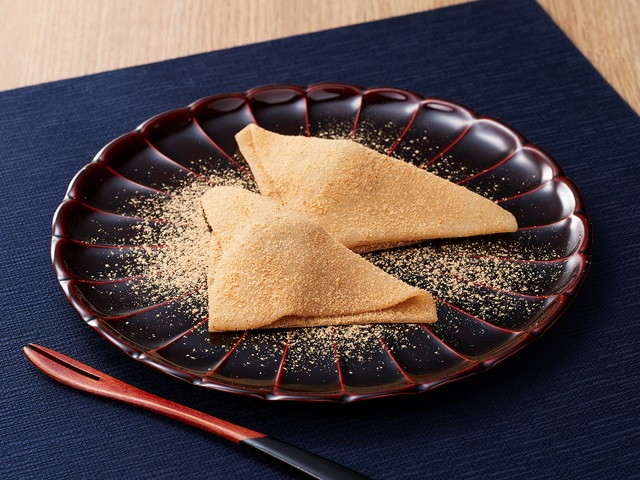
A surprisingly simple way to give your taste buds a trip to Kyoto whenever you want to.
A trip to Kyoto will leave you with life-long memories of the city’s tranquil gardens, historic architecture, and traditional culture. And if you do your Kyoto trip the right way, it should also leave you with life-long cravings for nama yatsuhashi, which you can see pictured above.
Nama yatsuhashi, Kyoto’s representative confectionary, are an evolved form of yatsuhashi, rice crackers seasoned with a mixture of cinnamon and kinako (roasted soybean powder). But whereas yatsuhashi are crisp and semi-cylindrical, shaped like long roof tiles, nama yatsuhashi are triangular folds of chewy mochi with a filling of anko (sweet red bean paste).
Nama translates literally to “raw,” but that’s meant here in a figurative sense, since while nama yatsuhashi are soft, the dough still has to be cooked. It turns out, though, that you can do all the necessary cooking in your microwave, and that nama yatsuhashi are pretty easy to make yourself, as Japanese spice company S&B posted a recipe for microwave-made nama yatsuhashi on their official website, and when we saw it we jumped at the chance to try it for ourselves.
The ingredient list is short and simple, consisting of just seven things:
● Shiratamako (glutinous rice flour) (50 grams [1.8 ounces])
● Joshinko (non-glutinous rice flour) (50 grams [1.8 ounces])
● Sugar (60 grams [2.1 ounces])
● Water (150 milliliters [5.1 ounces])
● Cinnamon (2 teaspoons)
● Kinako (roasted soybean powder) (3 tablespoons)
● Tsubu-an (sweet red bean paste) (100 grams [3.5 ounces])
Step 1
The above quantities are enough to make 10 pieces, so start by dividing up the tsubu-an into that many servings.
Step 2
In a bowl, mix together the cinnamon and kinako.
Step 3
Put the glutinous rice flour in a microwave-safe bowl and gradually add in half (75 milliliters) of the water, stirring the mixture enough to remove any lumps from the flour. Once that’s done, add the sugar, non-glutinous rice flour, and remaining water.
Step 4
Cover the bowl with plastic wrap and heat the mixture in the microwave for 1 minute and 30 seconds at 600 watts.
Step 5
Take the bowl out of the microwave and stir the contents again. Replace the wrap and put it back in the microwave for another minute and 30 seconds.
Step 6
After its second stint in the microwave, the once-liquid mixture will now have a thick and chewy (or, as it’s called in Japanese “mochi mochi”) quality!
It won’t have completely solidified, and you’ll actually need to use a bit of force to stir everything up a little more to get a uniform consistency.
It’s now time to add the cinnamon and kinako, which you could do by sprinkling it onto the dough, but a more effective method is to instead spread the powder onto a flat surface like a large cutting board…
…put the dough on top of it…
…and then flatten the dough out with a rolling pin, since you’re eventually going to need to form it into sheets anyway.
▼ S&B recommends rolling the mochi dough to a thickness of about 2 to 3 millimeters (roughly 0.1 inch).
Step 7
Let the dough cool, then cut it into squares of roughly 8 centimeters (3.1 inches) per side, using a knife or pizza cutter.
Place a dollop of sweet bean paste in the center of each square, then fold them into triangles.
Step 8
Finally, if you’ve got any of the cinnamon and kinako left over, you can use a tea strainer to finish off your treats with a dusting of the mixture.
And with that, your nama yatsuhashi are ready to eat!
We’ll admit that ours didn’t look quite as nice as the professionally made versions that are evergreen best-sellers in Kyoto souvenir shops, but considering this was our very first time to ever make them, we think our first batch looks pretty decent, with a certain charmingly rustic aesthetic going on.
But of course, the real test is how they taste, and when we took a bite, we were honestly surprised at how great they’d turned out! The sweetness of the tsubu-an, the fragrant and sophisticated elements of the cinnamon and kinako, and the invitingly soft and chewy texture of the mochi? They were all there, and so wonderful that, if we’d had our eyes closed while we were eating, we’re not sure we would have noticed any difference between the batch we’d whipped up with our microwave and a pack of professional store-bought nama yatsuhashi.
So now that we know we can make both nama yatsuhashi with our microwave and chanko nabe sumo wrestler stew in our rice cooker, we’re all set to make both dinner and dessert with minimum hassle and maximum deliciousness.
Reference, top image: S&B
Insert images ©SoraNews24
● Want to hear about SoraNews24’s latest articles as soon as they’re published? Follow us on Facebook and Twitter!
[ Read in Japanese ]